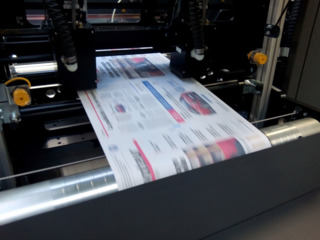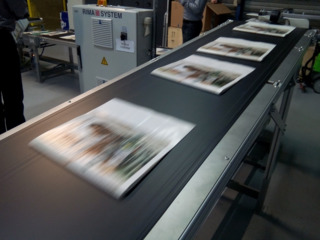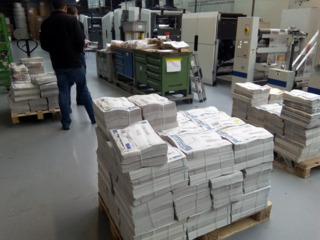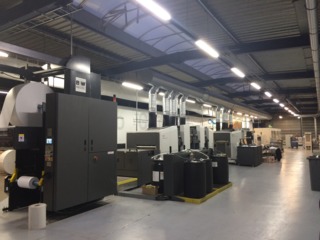The Hyper Local Newspaper Revolution
Inkjet opens up new possibilities for newspapers, but the adoption has been slow.

The world of newspapers is changing. While it hasn’t happened overnight, and the traditional model isn’t going to vanish either, there is no denying that the way people around the world consume their news is changing. Technology platforms is one reason for the shift, with many people, especially among the younger generation, turning to their mobile phones, computers and tablets as their consumption engine of choice.
But changes in the technology of print has also played a role.
Inkjet, in particular, has opened up new possibilities for printers of all types, but newspapers are seeing one of the more obvious shifts as more publishers worldwide are experimenting with a “hyper local” model.
But before you can discuss how the hyper local movement is shifting newspaper publishing, you first have to define it. After all, there have been versioned editions of the major newspapers — think the New York Times or Washington Post with their national and international editions, or the morning and afternoon editions of most city-based newspapers — but hyper local is far more specific. A hyper local newspaper won’t just be focused on an urban city, for example. It could be targeted to specific neighborhood in that city, with as many versions as there are neighborhoods.
The content in hyper local newspapers is then geared specifically to that neighborhood, in this example. A reader won’t hear about the results of the high school football team on the other side of town, they would only see the scores from their home team. And ads would be for the local businesses doing business in that neighborhood.
“I wouldn’t call it widely adopted, but it is being widely considered,” said Will Mansfield, Director, WW Sales & Marketing – Inkjet Presses, Enterprise Inkjet Systems, Kodak. “Publishers tend to be very conservative and quite risk adverse, and to make a change like this requires taking a risk and doing things differently than the last 50 years. Technologically it’s not hard to do at a distribution level, but it has some challenges, which can be overcome. The real challenge is rethinking the approach to editorial, stories and advertising.”
“I think the challenge with it is one on hand you get the ability to address a smaller, more relevant audience — which is good and if you can do that effectively, have more valuable information you can provide — but the other side of that is how does it get funded,” said Mike Herold, Director of Inkjet Technologies, Ricoh. “Today people are advertising in a newspaper to a very large audience of the entire paper. But it’s been proven by studies that if ads are more specific, they are more likely to drive changes. For newspapers to be effective they have to be able to drive the revenue on that deliverable in same way they do the content.”
And that challenge — figuring out how to sell ad space in an effective way to support a hyper local edition — is the biggest hurdle to adoption today. The content, in comparison, is relatively easy, with the system already set up to handle beats and reports who cover very specific areas or types of stories. That is very easy to transition to a hyper local model. On the other hand, right now most newspapers sell their advertising based on the large number of impressions they will get across their entire readership. However, a hyper-local edition might see a small fraction of the readers, making figuring out how to charge for it a more complex proposition. On the flip side, by having hyper local advertising, it means a newspaper could sell the same ad space several times over to different communities. So the potential is there, it is just a matter of shifting the way they approach the sales process.
Disrupting the Status Quo
There is no denying that the hyper local movement has absolutely taken off far quicker in other parts of the world than it has here in the United States. Herold noted that he believes more publishers will start to look at the concept and consider how they could make it work for them. “To completely ignore this option is not good idea for a traditional publisher,” he said. He went on to note, however, that he sees the newer publishers as driving more of the innovation, in the short term at least.
“The more predominant role will be the smaller — not start ups but newer — publishers as a disruptor in the market. How do we turn the industry on its head a bit? It might not be being done because current players can’t turn the ship and do it, and we see that in lots of industries today — that’s how they get disrupted. If they can do that and have a successful business case, it will shake up the market.” He cautioned, however, that it isn’t quite so clear-cut as it is in other industries that have seen disruption, since newspapers aren’t the only option when it comes to consuming information. “That’s where it gets more challenging. They are not just shaking up a single industry, but one that has multiple ways of delivering and consuming.”
Mansfield agreed, clarifying that, “New publishers aren’t startups. They are consortiums of publishers who have gotten together to create a new business model, as well as some traditional publishers who have adopted inkjet.”
Both experts agreed that the question of hyper local newspapers really isn’t one of capability — the inkjet technology exists today to do it cost effectively, either printing the entire run on a dedicated inkjet press, or with inkjet components that are integrated into an existing offset press. The real challenge now is finding the business model to best support that type of operation.
Newspapers have seen a lot of change in the last decade. They have seen their relevance as the go-to source for news dwindle worldwide as new technologies are created to give people instant and more global access to news than they have ever had in the history of our species to date. The hyper local newspaper could provide content and advertising that these other platforms just can’t touch right now, giving readers information about their local neighborhoods that online or Internet-based sources can’t match. And while it might be a slow build toward adoption, it is very likely the future of the market.



